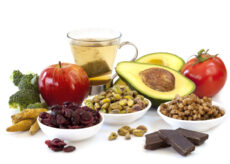Are You Deficient? The 4 Nutrients People Over 40 Don’t Get Enough of

As most of us are constantly barraged by food and engulfed by an environment that promotes overeating, you may find it hard to believe that you’re likely deficient in several essential nutrients. Yet considering that most diets consist of too many nutrient-sparse, ultra-processed foods, nutrient deficiencies really shouldn’t come as much of a surprise.
According to a number of studies, several “shortfall nutrients” are the most common when it comes to nutrient deficiencies.1–3 The USDA identifies these as “nutrients of concern” because when underconsumed, they “pose a substantial public health concern.”
The Top 4 Nutrient Deficiencies

Nutrient Deficiency #1: Vitamin D
Why YOU should be concerned: Commonly referred to as the “sunshine vitamin,” the bioactive form of vitamin D actually serves as a hormone in the body.4 The benefits of vitamin D far surpass healthy bones. Nearly every tissue in the body has a vitamin D receptor, including cells of the pancreas, immune system, skin, thyroid, stomach, colon, and more.5,6 Unfortunately, vitamin D deficiency is prevalent throughout the world.7
How much do you need: This is a bit tricky and actually fairly controversial. The Institute of Medicine (IOM) has set a Dietary Reference Intake (DRI) of 600 IU per day for adult men and women. However, for the most accurate assessment of your vitamin D and nutrient deficiencies, consider getting your blood levels of 25-hydroxyvitamin D (i.e., [25(OH)D]) tested and base your intake and sun exposure on your results.
Where you can get it: Sunlight exposure (on bare skin) is the number one way to boost levels of vitamin D. It’s estimated that sunlight exposure accounts for upwards of 90% of the vitamin D in circulation.8 The best natural food sources include oily fish (e.g., wild salmon, sardines, mackerel), egg yolks, and mushrooms. Dairy products are often fortified with vitamin D as well.

Nutrient Deficiency #2: Magnesium
Why YOU should be concerned: Did you know ALL cells in your body require magnesium? Did you know that magnesium is involved in over 300 enzymatic reactions and biological processes? Did you know magnesium plays an important role in energy production, metabolic rate, blood glucose management, protein production, and more?
While most people associate magnesium with bone health (and it’s definitely important), magnesium also helps with energy production, exercise performance, mood, feelings of well-being, heart health, glycemic control, muscle soreness, and migraine headaches.
However, magnesium deficiency is very common. In fact, about 50% of Americans fall well short of the DRI for magnesium! This isn’t good as magnesium deficiency can increase the risk of type 2 diabetes, metabolic syndrome, Alzheimer’s disease, and cardiovascular disease.9
How much do you need: The DRI for magnesium is 400 – 420 mg per day for men and 320 – 360 mg per day for women.
Where you can get it: Dark green leafy vegetables (such as spinach, Swiss chard, turnip greens, beet greens, mustard greens, and kale), legumes, nuts, seeds, and whole grains are all good sources of magnesium. Generally speaking, whole foods that are good sources of fiber tend to provide magnesium. Speaking of fiber…

Nutrient Deficiency #3: Fiber
Why YOU should be concerned: Fiber is well-known for its beneficial effects on heart health, glycemic control, digestive health, and weight management. However, the average intake of dietary fiber in the United States is a paltry 17 grams per day, with only 5% (talk about one of the most common nutrient deficiencies) of the population meeting the Adequate Intake (AI).
How much do you need: The AI, which is established by the IOM based on the median fiber intake level observed to achieve the lowest risk of coronary heart disease, is 25 grams per day for adult women and 38 grams per day for adult men.
Where you can get it: A variety of fruits, vegetables, legumes, whole grains, nuts, and seeds.
Special Offer:Get MetaboGreens up to 20% OFF (very limited inventory)

Nutrient Deficiency #4: Water
Why YOU should be concerned: It seems like a no-brainer that good hydration is vital for overall health and well-being. However, water is often overlooked as an essential nutrient. Along those lines, even very mild dehydration is linked to a variety of chronic diseases and reduced cognitive performance (e.g., poor focus, energy, memory, etc.).10
How much do you need: The IOM suggests that men drink 2.6 liters of water per day (~88 ounces) and women drink 1.8 liters per day (~61 ounces). These are general recommendations, which can vary wildly depending on body size, activity levels, environment (e.g., humidity, temperature), sweat rate, etc.
Where you can get it: The obvious answer is by drinking more pure water. However, you can also increase your water intake by consuming more vegetables and fruits, which have a very high water content. Along those lines, the IOM suggests the total water intake (food and beverage) for men is 3.3 liters per day and 2.3 liters per day for women.






